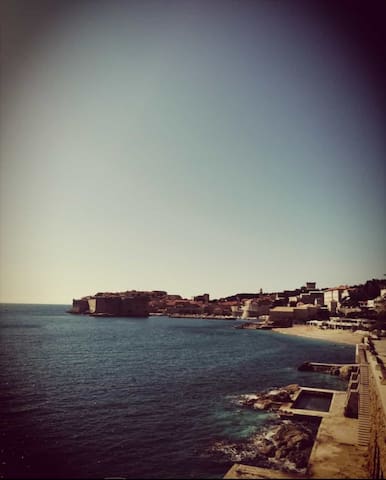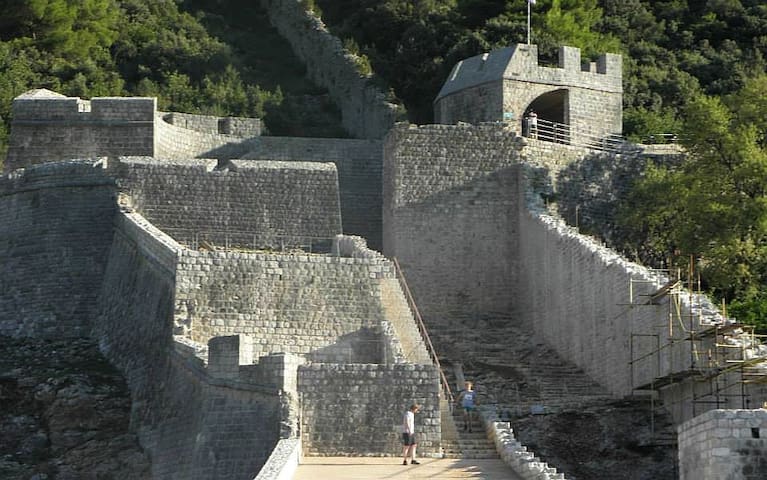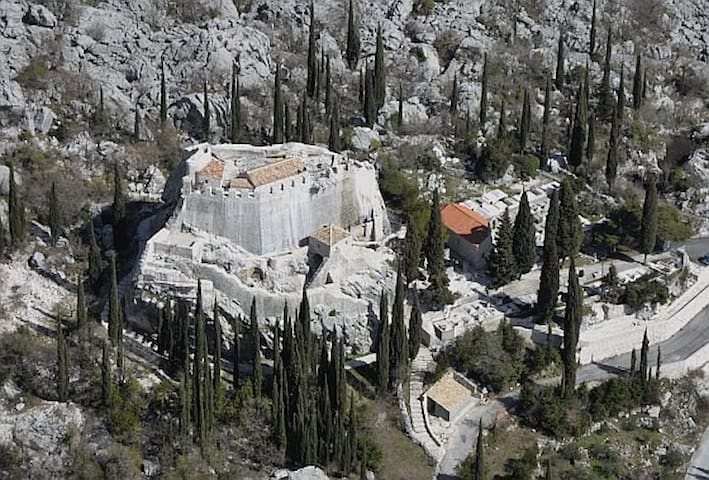Razgledavanje
Dubrovnik and its area cover the territory of the southern part of the Republic of Croatia and its province of Dalmatia. Its borders run from Neum in the west to Sutorina and Ponta Ostra in the east. This area lies between Bosnia and Herzegovina in the north and the Montenegro in the east.
This spread-out, comparatively narrow piece of coastline, lying below the rocky mountain range of the Dinara and some smaller mountains, becomes wider in its eastern part and develops into the small rocky Konavosko Polje, including here the mountain Snijeznica, with its mountainous part, where the coast seems as if to enter the land.
The border-line of this area goes along the mountain tops on the side of Herzegovina and partly on the side of Montenegro. In some places the area along the coast is not more than a hundred meters wide - like in Duboka Ljuta.
The geographical position of Dubrovnik and the area of the southern part of the eastern Adriatic coast is extremely favourable, being situated at the end of the Adriatic archipelago and at the foot of the comparatively small mountains that can be explored on toot. These mountains have offered a favourable territory for the caravaning trade travelling on the whole of the Balkan territory.
At the same time the mountain range represents a natural shield defending the area from the cold currents of the continental climate; this is one of the geographical factors that have this exceptionally mild, the real Mediterranean climate of the Dubrovnik area as its consequence.
According to the Greenwich measurements Dubrovnik is situated at 42028 of the northern latitude, like Rome and Barcelona, and at 1807 eastern longitude, like Stockholm. These are the advantages of the geographical position that cause the subtropical climate and the rich vegetation.
Dubrovnik is now the seat of the City Council. The present-day borders of the Dubrovnik area are to a greater extent those of the old Dubrovnik Republic. They pass along the larger part of the Peljesac peninsula, including Ston.
The area of Dubrovnik further includes the area of the Dubrovnik coastal belt, from Neum to Rijeka Dubrovacka.
Next to Rijeka Dubrovacka are Zupa Dubrovacka, Konavle with Cavtat, the Elaphite islands Sipan, Lopud and Kolocep, the largest of the islands - Mljet,
and a few smaller uninhabited islands - Olip, Jakljan, Daksa, Sveti Andrija, Lokrum, Bobara, Supetar and Mrkan, stretching from Ston to Cavtat. In front of the city is the island of Lokrum.
The oldest area of the old Dubrovnik Republic, called Astarea, meaning the "land of the fathers", used to spread from Cavtat to Orasac, including Zupa Dubrovacka together with Brgat, Rijeka Dubrovacka and Zaton. All this belonged to Dubrovnik from ancient days.
With the beginning of the 11th century the Republic started widening its territory to complete the expansion by the 15th century, establishing borders that have been defended until the fall of the Republic.
In the 11th century the Republic took over the Elaphite islands, in the 13th century the Republic established its power on the island of Lastovo,
in 1333 the Republic got Ston with Peljesac, and soon afterwards the island of Mljet as well.
In 1399 the area from Ston to Orasac became Republican territory and finally Konvale and Cavtat were also added to it in 1419 and 1427.
On the other hand, to keep its territory safe the Republic had used arms to fight and defend its integrity against numerous attacks of various enemies.
516 當地人推薦
Dubrovnik
Dubrovnik and its area cover the territory of the southern part of the Republic of Croatia and its province of Dalmatia. Its borders run from Neum in the west to Sutorina and Ponta Ostra in the east. This area lies between Bosnia and Herzegovina in the north and the Montenegro in the east.
This spread-out, comparatively narrow piece of coastline, lying below the rocky mountain range of the Dinara and some smaller mountains, becomes wider in its eastern part and develops into the small rocky Konavosko Polje, including here the mountain Snijeznica, with its mountainous part, where the coast seems as if to enter the land.
The border-line of this area goes along the mountain tops on the side of Herzegovina and partly on the side of Montenegro. In some places the area along the coast is not more than a hundred meters wide - like in Duboka Ljuta.
The geographical position of Dubrovnik and the area of the southern part of the eastern Adriatic coast is extremely favourable, being situated at the end of the Adriatic archipelago and at the foot of the comparatively small mountains that can be explored on toot. These mountains have offered a favourable territory for the caravaning trade travelling on the whole of the Balkan territory.
At the same time the mountain range represents a natural shield defending the area from the cold currents of the continental climate; this is one of the geographical factors that have this exceptionally mild, the real Mediterranean climate of the Dubrovnik area as its consequence.
According to the Greenwich measurements Dubrovnik is situated at 42028 of the northern latitude, like Rome and Barcelona, and at 1807 eastern longitude, like Stockholm. These are the advantages of the geographical position that cause the subtropical climate and the rich vegetation.
Dubrovnik is now the seat of the City Council. The present-day borders of the Dubrovnik area are to a greater extent those of the old Dubrovnik Republic. They pass along the larger part of the Peljesac peninsula, including Ston.
The area of Dubrovnik further includes the area of the Dubrovnik coastal belt, from Neum to Rijeka Dubrovacka.
Next to Rijeka Dubrovacka are Zupa Dubrovacka, Konavle with Cavtat, the Elaphite islands Sipan, Lopud and Kolocep, the largest of the islands - Mljet,
and a few smaller uninhabited islands - Olip, Jakljan, Daksa, Sveti Andrija, Lokrum, Bobara, Supetar and Mrkan, stretching from Ston to Cavtat. In front of the city is the island of Lokrum.
The oldest area of the old Dubrovnik Republic, called Astarea, meaning the "land of the fathers", used to spread from Cavtat to Orasac, including Zupa Dubrovacka together with Brgat, Rijeka Dubrovacka and Zaton. All this belonged to Dubrovnik from ancient days.
With the beginning of the 11th century the Republic started widening its territory to complete the expansion by the 15th century, establishing borders that have been defended until the fall of the Republic.
In the 11th century the Republic took over the Elaphite islands, in the 13th century the Republic established its power on the island of Lastovo,
in 1333 the Republic got Ston with Peljesac, and soon afterwards the island of Mljet as well.
In 1399 the area from Ston to Orasac became Republican territory and finally Konvale and Cavtat were also added to it in 1419 and 1427.
On the other hand, to keep its territory safe the Republic had used arms to fight and defend its integrity against numerous attacks of various enemies.
Medieval little town with whose history reaches back as far as the 14th century.It is a small town with the longest stone wall in Europe(5,5km),with narrow quiet streets,noble ancient houses and with traces of ancient cultures. Its former value as a „salt city“ gets confirmed even today in the plants of the oldest active salt-works in the world.These saltworks have remained faithfull to the tradition and to the natural way of salt production which has not changed since remote ages. Restaurant Bacus
170 當地人推薦
Ston
Medieval little town with whose history reaches back as far as the 14th century.It is a small town with the longest stone wall in Europe(5,5km),with narrow quiet streets,noble ancient houses and with traces of ancient cultures. Its former value as a „salt city“ gets confirmed even today in the plants of the oldest active salt-works in the world.These saltworks have remained faithfull to the tradition and to the natural way of salt production which has not changed since remote ages. Restaurant Bacus
Trsteno Arboretum, located in Trsteno, Croatia, is the oldest arboretum in this part of the world.
The arboretum was erected by the local noble family Gozze (see House of Gozze) in the late 15th century, who requested ship captains to bring back seeds and plants from their travels. The exact start date for the arboretum is unknown, but it was already in existence by 1492, when a 15 m span aqueduct to irrigate the arboretum was constructed; this aqueduct is still in use. It has been the property of the Croatian Academy of Sciences and Arts since 1948, when it was donated. The Arboretum reserves a very special place among the old Ragusa, Dalmatian and Mediterranean parks. It includes a park surrounding the fifteenth century summer residence, which is a monument of garden architecture, and a nineteenth century park at Drvarica.
169 當地人推薦
特斯特諾
20 PotokTrsteno Arboretum, located in Trsteno, Croatia, is the oldest arboretum in this part of the world.
The arboretum was erected by the local noble family Gozze (see House of Gozze) in the late 15th century, who requested ship captains to bring back seeds and plants from their travels. The exact start date for the arboretum is unknown, but it was already in existence by 1492, when a 15 m span aqueduct to irrigate the arboretum was constructed; this aqueduct is still in use. It has been the property of the Croatian Academy of Sciences and Arts since 1948, when it was donated. The Arboretum reserves a very special place among the old Ragusa, Dalmatian and Mediterranean parks. It includes a park surrounding the fifteenth century summer residence, which is a monument of garden architecture, and a nineteenth century park at Drvarica.
This fort found itself under Dubrovnik rule in 1420 and was immediately submitted to further construction – rebuilding of certain parts, strengthening of others, arming and general maintenance. This fort survived unscathed the big earthquake of 1667.
It is not mentioned in the 1672 archives as a military complex and it was probably abandoned around that time. As was customary in the region, the locals used the stones of the fort to build their homes and smaller walls, so Fort Sokol was heavily deconstructed. The ruins of the fort have been placed under state protection and are maintained in their present condition. Time table: 10:00 – 18:00 (1.4.– 31.5.) 10:00 – 19:00 (1.6.– 31.10.) 10:00 – 16:00 (1.11.– 30.11.) 12.00 – 15.00 (1.12. – 31.3.) Ticket Prices: Adult: 70 kn Group, voucher: 50 kn Children 7-18 years: 30 kn
80 當地人推薦
索科爾塔
This fort found itself under Dubrovnik rule in 1420 and was immediately submitted to further construction – rebuilding of certain parts, strengthening of others, arming and general maintenance. This fort survived unscathed the big earthquake of 1667.
It is not mentioned in the 1672 archives as a military complex and it was probably abandoned around that time. As was customary in the region, the locals used the stones of the fort to build their homes and smaller walls, so Fort Sokol was heavily deconstructed. The ruins of the fort have been placed under state protection and are maintained in their present condition. Time table: 10:00 – 18:00 (1.4.– 31.5.) 10:00 – 19:00 (1.6.– 31.10.) 10:00 – 16:00 (1.11.– 30.11.) 12.00 – 15.00 (1.12. – 31.3.) Ticket Prices: Adult: 70 kn Group, voucher: 50 kn Children 7-18 years: 30 kn
Omiljeno mjesto lokalaca
Just a 10 minute drive west of Orašac lies the small village of Brsecine and its beach of Veliki Zali.
The beach is covered with large pebbles which locals call "zal" (thus the name Veliki Zali, meaning “Large Pebbles”).
In addition to untouched nature, the beach is known for the cleanness of its sea and surroundings, as well as for being intimate and uncrowded.
The seaside restaurant Veliki Zal offers fresh, delicious grilled food, while it's cocktail bar and cafe serve cool cocktails and aromatic espresso.
Sunbeds, sun umbrellas and kayaks can be rented at the beach for your leisure time, and for those with a more adventurous spirit a wide range of water-sports is available.
Situated under Jadranska Magistrala road, it is very accessible by car, which can be left on a local parking lot free of charge.
Hawai
Veliki zali
城市建議
出發前完成預訂
Dubrovnik Card
This is your link for buying Dubrovnik card.
http://www.dubrovnikcard.com/
This card has the benefits for you.
Includes visiting walls, some museums. in some restaurants you also have a discount with this card.
Please read about all of for your information
交通資訊
suburbantimetable
https://www.libertasdubrovnik.hr/
suburbantimetable
bus No. 12, 15,26 and 35
切勿錯過
Trip to the Elaphite Island
You have ship from our village to go to the Elaphite island . The trip starts at 10 30 for you guys on the resort harbour . You will have 3 stop one hour on Kolocep island, 1.5 hour on Sipan and 2.5 hour on Lopud. You get included launch either vegitarenian, meat or fish with included wine. The othee drinks you have to pay for.
If you want a more intimate trip to the Elaphite, just for you. We recommend renting a boat with a phenomenal local guide.
交通資訊
Transfers
Agency head office is situated in Dubrovnik, and other two branch offices are situated at Dubrovnik Sun Gardens Resort and Dubrovnik Airport, while our sister agency is based in Korčula Town, located on the northeastern end of Korčula Island.
http://www.korkyra-dubrovnik.com/transfers.html
切勿錯過
19 Game of Thrones Filming Locations in Dubrovnik
1| Pile Gate Entrance to Old Town,
2 | Pile Harbour: Bokar Fortress and Fort Lovrijenac,
3 | Dubrovnik West Pier,
4 | Dubrovnik West Harbour,
5 | Fort Lovrijenac,
6 | Gradac Park,
7 | Fort Bokar,
8 | The City Walls,
9 | Minčeta tower,
10 | Ethnographic Museum,
11 | The Jesuit Staircase,
12 | The Rector’s Palace,
13 | The Stradun,
14 | St Dominic Street,1
15 | Dominican Monastery,
16 | Ploče Gate,
17 | Hotel Belvedere,
18 | Lokrum island,
19 | Trsteno Arboretum





